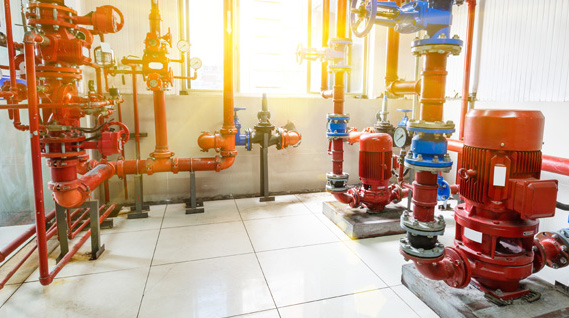Although we are only a few weeks into the New Year, it is time to start thinking ahead to springtime and having your fire pump inspected. The NFPA 25 stipulates a certain number of fire pump inspections and test, including quarterly, semiannual, annual, and five-year checks. Additionally, insurance companies have their own requirements. Operations or facility managers must be very clear with their fire protection server provider about what their insurance company actually requires in order to be fully covered should a fire actually occur.
Here are a few questions that we are commonly asked about fire pumps:
What exactly does a fire pump do and why do I need one?
A fire pump increases the pressure coming from your water source to the rate that is required by your fire sprinkler system to respond in the event of a fire. Different pump sizes raise the pressure to different rates, so it should be sized appropriately when the system is first installed and when it is inspected every time there is a change to your building’s layout. Fire Pumps are not actually required in every building – only in the ones in which the requirements of the fire sprinkler system actually exceed the capabilities of the water supply.
What does a fire pump test include?
During an annual fire pump inspection and test, technicians will carefully check all of the necessary lines and incoming voltage. They will specifically look at all three of the phase to make sure that there is not excessive voltage going to the panel, which could cause it to short out. The technician will look for internal problems with the pump and make sure that it is performing per its design standards, and will also check the amps and revolutions per minute on the shaft that runs the fire pump’s engine. He or she will also perform a flow test at 100 and 150% of the pump’s rated value to ensure that the fire pump can meet the system demand.
What happens if I miss my fire pump test?
If your fire pump is not properly cared for, it will most likely not perform to its design standard. This means that there is a high chance that a fire will not be put out if one does occur.
What should I do to my fire pump between tests to keep it in good shape?
The best and biggest maintenance to perform on your pump is to run it on a monthly or weekly basis (depending on the pump type). Make sure that your drain lines are draining and not flooding any areas, and that the area where your fire pump is located is clear of anything that could prevent a clog.
For more information on fire pumps or to schedule your inspection, contact the experts at A Total Solutions, Inc. today!
